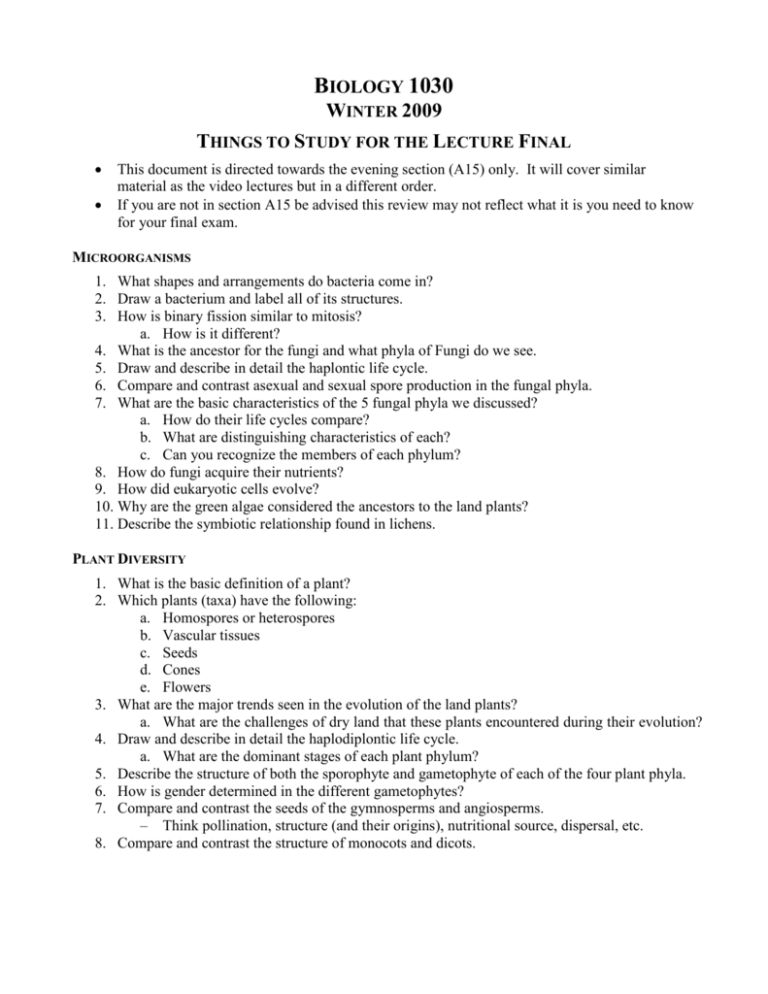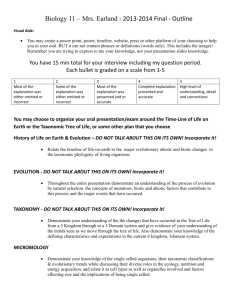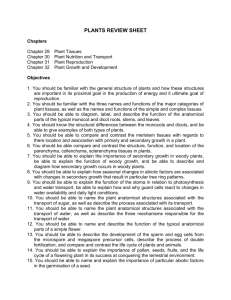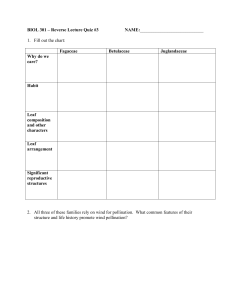THINGS TO STUDY FOR THE FINAL EXAM
advertisement

BIOLOGY 1030 WINTER 2009 THINGS TO STUDY FOR THE LECTURE FINAL • • This document is directed towards the evening section (A15) only. It will cover similar material as the video lectures but in a different order. If you are not in section A15 be advised this review may not reflect what it is you need to know for your final exam. MICROORGANISMS 1. What shapes and arrangements do bacteria come in? 2. Draw a bacterium and label all of its structures. 3. How is binary fission similar to mitosis? a. How is it different? 4. What is the ancestor for the fungi and what phyla of Fungi do we see. 5. Draw and describe in detail the haplontic life cycle. 6. Compare and contrast asexual and sexual spore production in the fungal phyla. 7. What are the basic characteristics of the 5 fungal phyla we discussed? a. How do their life cycles compare? b. What are distinguishing characteristics of each? c. Can you recognize the members of each phylum? 8. How do fungi acquire their nutrients? 9. How did eukaryotic cells evolve? 10. Why are the green algae considered the ancestors to the land plants? 11. Describe the symbiotic relationship found in lichens. PLANT DIVERSITY 1. What is the basic definition of a plant? 2. Which plants (taxa) have the following: a. Homospores or heterospores b. Vascular tissues c. Seeds d. Cones e. Flowers 3. What are the major trends seen in the evolution of the land plants? a. What are the challenges of dry land that these plants encountered during their evolution? 4. Draw and describe in detail the haplodiplontic life cycle. a. What are the dominant stages of each plant phylum? 5. Describe the structure of both the sporophyte and gametophyte of each of the four plant phyla. 6. How is gender determined in the different gametophytes? 7. Compare and contrast the seeds of the gymnosperms and angiosperms. – Think pollination, structure (and their origins), nutritional source, dispersal, etc. 8. Compare and contrast the structure of monocots and dicots. PLANT REPRODUCTION, DEVELOPMENT, FORM & FUNCTION 1. What organs do plants possess? Tissues? Cells? a. Compare and contrast the structures and functions of each. 2. How is the dependence (or lack thereof) on water reflected in the plants’ structures? 3. Compare and contrast pollination in the seed plants. 4. What are the organs of the embryo? a. What do they develop into? 5. What is required for seed germination? 6. What structures produce the tissues of a growing plant? a. How do roots grow? Lateral roots? b. How do shoots grow? c. How do leaves grow? d. What are the mechanisms of cell elongation in each? 7. Diagram and label cross sections of the roots and stems from dicots and monocots. 8. How can the organs of plants be modified to meet specific needs? 9. What cellular processes occur in the cells of a root, shoot and leaf? 10. How do plants prevent/control water loss? 11. Describe the lateral or secondary growth in woody plants. a. What tissues are involved and which tissues are produced? MEETING TISSUE NEEDS II 1. What do plant cells/tissues need? 2. Review the basics of photosynthesis from Biology 1020. You should know the reactants and products for each stage. 3. How do plants generate ATP for cellular work? 4. What are the essential nutrients for plants and how do they use them? a. How are these essential nutrients acquired? 5. How does bulk flow work? 6. How does water potential drive transpiration? a. Describe the role of cohesion and adhesion in transpiration. 7. Under what conditions would stomata be open? Closed? 8. Describe translocation. a. What are the sources and sinks? 9. How do plants absorb nutrients and water? a. How do they control absorption? 10. Describe root pressure. PLANT COORDINATION 1. 2. 3. 4. In general, how do plants react to stimuli? What are secondary messengers and where do you see them used? What are some ways that plants protect themselves from predation? Where are growth regulators produced? a. Where are they used? b. What are the functions of the growth regulators we discussed in class? 5. Compare and contrast phototropism and gravitropism. 6. Describe the mechanisms of apical dominance, the triple response, leaf abscission and fruit ripening. LIST OF IMPORTANT TERMS MICROORGANISMS Coccus Bacillus Coccobacillus Spiral Pleomorphic Nucleoid Capsule Pilus Bacterial flagellum Binary fission Internal membranes Heterocysts Hypha Mycelium Haplontic Plasmogamy Karyogamy Heterokaryotic Rhizoids Coenocytic Sporangium Zygosporangium Arbuscular mycorrhiza Ascocarp Ascospore Conidia Basidiocarp Basidiospore Mixotroph Endomembrane theory Endosymbiotic theory Pigment Accessory pigment Blade Stipe Holdfast Lichen Mycobiont Photobiont Dermal tissue Protonema Gametophores Thallus Cuticle Xylem Phloem Parenchyma Collenchymas Sclerenchyma Perennial Annual Antheridiogen Sporophyll SAM RAM Sorus Ovule Pollen Mega(micro)sporangium Mega(micro)sporocyte Mega(micro)spore Mega(micro)gametophyte Monocot Dicot Simple fruit Aggregate fruit Compound fruit Accessory fruit PLANT DIVERSITY Autotrophic Haplodiplontic Sporophyte Gametophyte Spore Sporangium Gametangium Archegonium Antheridium Shoot Rhizome Root Leaf Vascular tissue Ground tissue PLANT REPRODUCTION, DEVELOPMENT, FORM & FUNCTION Homospory Heterospory Direct pollination Indirect pollination Micropyle Double fertilization Endosperm Cotyledon Epicotyl Hypocotyl Radicle Trichome Cuticle Vessel element Tracheid Sieve-tube element Companion cell Lignin Sclerid Fibre Primary root Lateral root Adventitious root Zone of division Zone of elongation Zone of maturation Meristem cell Turgor pressure Wall pressure Stele Pericycle Endodermis Cortex Pith Terminal bud Node Internode Axillary bud Stipule Petiole Blade Simple leaf Compound leaf Pinnate Palmate Alternate leaves Opposite leaves Palisade mesophyll Spongy mesophyll Stomata Guard cells Abscission Whorls Sepal Petal Stamen Pistil/Carpel(s) Vascular cambium Secondary xylem Secondary phloem Cork cambium Cork Periderm Water potential Transpiration Cohesion Adhesion Translocation Source Sink Mass flow hypothesis Root hair Mycorrhiza Nitrogen fixation Symplast Apoplast Root pressure Growth regulator Auxin Cytokinin Gibberelin Ethylene Abscissic acid Acid-growth hypothesis Phototropism Gravitropism Apical dominance Aleurone Triple response MEETING TISSUE NEEDS II Photosynthesis Essential mineral Active transport Secondary transport Bulk flow Xylem sap Phloem sap PLANT COORDINATION Etiolation De-etiolation Signal transduction Thigmomorphogenesis Pulvinus Turgor pressure TAXA AND COMMON NAMES YOU ARE RESPONSIBLE FOR DOMAIN Bacteria KINGDOM Monera Eukarya Excavata * Opisthokonta * Chromalveolata * Archaeplastida * PHYLUM COMMON NAMES bacteria Euglenoids Nucleariids Brown algae Red algae Green algae Fungi Chitridiomycota Zygomycota Glomeromycota Ascomycota Basidiomycota the chytrids molds mycorrhizae sac fungi club fungi Plantae Bryophyta Pterophyta Coniferophyta Anthophyta the mosses the ferns the conifers the flowering plants * These are Supergroups (a taxon above Kingdom) that I only include for reference; you do not need to know these names.









